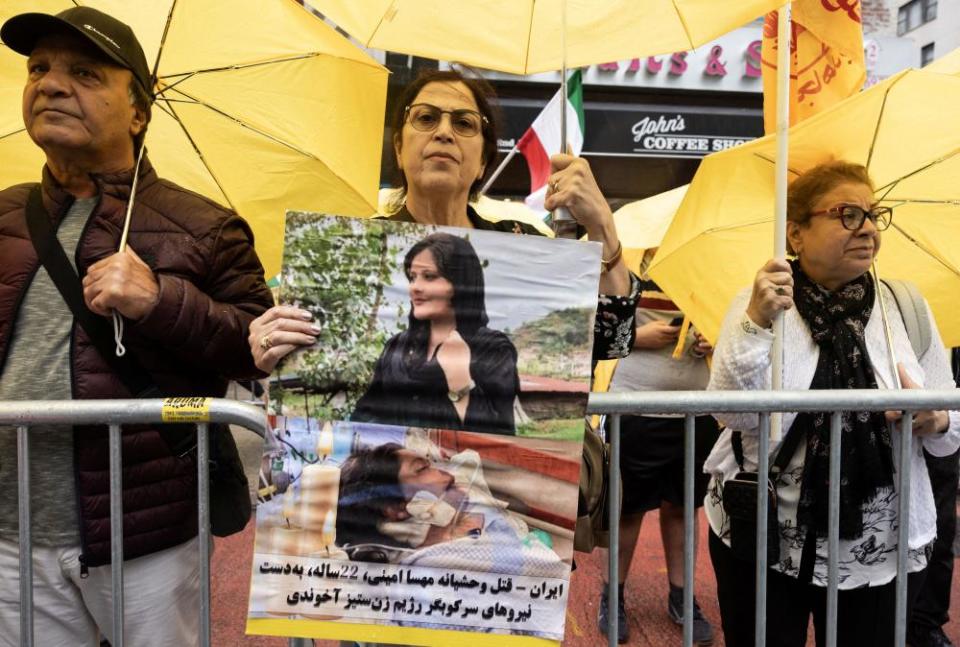Iran leader shuns Christiane Amanpour interview over refusal to wear headscarf
- Oops!Something went wrong.Please try again later.
- Oops!Something went wrong.Please try again later.
Iran’s president, Ebrahim Raisi, has cancelled an interview in New York with the veteran CNN correspondent Christiane Amanpour after she refused to wear a headscarf at his request.
Related: Iran blocks capital’s internet access as Amini protests grow
In a series of tweets, the chief international anchor of CNN said that she had been scheduled to meet Raisi on the sidelines of the United Nations general assembly, and had planned to ask him about various topics, including the outbreak of protests in Iran following the death in custody of Mahsa Amini, 22, who was arrested and beaten by “morality police” for violating headscarf laws.
“This was going to be President Raisi’s first ever interview on US soil, during his visit to NY for UNGA. After weeks of planning and eight hours of setting up translation equipment, lights and cameras, we were ready. But no sign of President Raisi,” Amanpour tweeted on Thursday.
Forty minutes after the interview was scheduled to begin, an aide approached Amanpour and told her that Raisi was “suggesting [she] wear a headscarf, because it’s the holy months of Muharram and Safar”, she wrote.
Amanpour said she declined the request, explaining that “we are in New York, where there is no law or tradition regarding headscarves”. She added that no other Iranian president has required that she wear a headscarf when she interviewed them outside Iran.

“The aide made it clear that the interview would not happen if I did not wear a headscarf. He said it was ‘a matter of respect’, and referred to ‘the situation in Iran’ – alluding to the protests sweeping the country,” Amanpour said.
“Again, I said that I couldn’t agree to this unprecedented and unexpected condition.”
As a result, Amanpour and her team walked away and the interview did not take place. A picture Amanpour posted at the end of her tweets showed her wearing a white suit while sitting across from an empty chair as she awaited the Iranian president, her hair uncovered.
And so we walked away. The interview didn’t happen. As protests continue in Iran and people are being killed, it would have been an important moment to speak with President Raisi. 7/7 pic.twitter.com/kMFyQY99Zh
— Christiane Amanpour (@amanpour) September 22, 2022
The British-Iranian journalist’s refusal to wear a headscarf was met with widespread praise online.
“Good for @amanpour. The days in which Iranian officials require female reporters and officials to wear the hejab in order to get interviews and meetings should be over. Forced hejab reflects an antiquated and intolerant ideology not a culture,” tweeted Karim Sadjadpour, an Iranian-American policy analyst at the Carnegie Endowment, a DC-based thinktank.
The NPR radio host Esther Ciammachilli retweeted Amanpour’s photo, writing, “What they mean when they say, ‘A picture is worth a thousand words.’ Christiane Amanpour’s integrity is fully intact.”
Bahman Kalbasi, the New York and UN correspondent for BBC’s Persian Service, echoed similar sentiments, tweeting: “Raisi doesn’t show up to interview with CNN after Christiane Amanpour refuses to put on regime’s hijab. Iran regime’s president seems to think he can impose the hijab in NYC too. #MahsaAmini.”

Raisi was repeatedly asked about Amini’s death during a briefing with reporters on Thursday morning which Iranian officials initially tried to confine to the subject of negotiations over Iran’s nuclear deal with the west.
Raisi repeated official claims that Amini had died from a heart attack or stroke while in custody and said similar deaths in custody had occurred in the US and UK.
At least three women who attended the briefing were not wearing headscarves. One New York Times reporter was barred from the briefing for reporting that Iran’s supreme leader Ayatollah Ali Khamenei was seriously ill.
In a statement released Thursday, a New York Times spokesperson said: “Iranian state media has reported comments made by an official that a New York Times correspondent must ‘admit a mistake’ in her coverage of Ayatollah Ali Khamenei in order to attend a press conference with President Raisi.”
“We stand by our reporting by Farnaz Fassihi on the health of Iran’s Supreme Leader Ayatollah Ali Khamenei, which was corroborated by senior sources. Iranian officials were given the opportunity to comment on our story and chose not to respond,” the spokesperson added.
At least 31 people have died in six days of protests since Amini’s death. Iranian women have been taking to the streets and the internet to burn their headscarves and cut their hair.
“A law that tramples on human dignity isn’t a normal law,” said one female protester.

